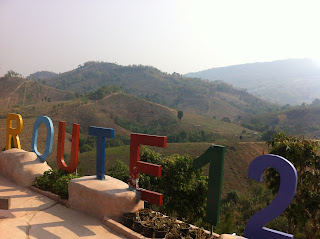
The park is located both in Phitsanulok and in Petchabun provinces. It is a vast expanse of mountain ridges, ponds, grassland (or savanna), and forests. Streams zigzag through the pine and evergreen forests, and there are of course several caves and waterfalls in the ridges. The mountain peaks in the west of park are the tallest with some reaching 1,500 meters above sea level.
The area has an interesting history. It surveyed in 1959 in preparation for becoming a national park, but the area was closed to the public between 1968 and 1982 as the Royal Thai Army conducted operations against communist guerillas that were hiding in the area.

The park headquarters is located at km. 80 on Highway No. 12. Information on the park and accommodations can be obtained there, trekking / biking tours can start from there, and the peace of camping on the bank of Huai Khek can be enjoyed. Cars are no longer allowed access to Thung Saleng Luang’s main savannah from the park headquarters – i.e., from the north – they have to enter the park at Nong Mae Na.
All in all, there are 11 big and small savannas in the park spread along the left bank of the Huai Khek Yai River. The largest savanna (where the Nong Mae Na ranger station is located) covers around 10 square kilometers. By the end of the rainy season, the grass will often have grown as high as eye-level of a Thai soldier thus making hiding easy.
A purple flower (ngon nak) has adapted to the tall grass with impressively tall stems.
The evergreen forests shed their leaves to reduce evaporation during the dry season. Before the leaves are shedded, they turn yellow, orange, red, and brown thus giving the forest a wonderful “autumn look”.

In the southern part of the park, you’ll find Thung Nang Phaya, which probably is one of the largest pine forests in Thailand. It contains some very old and tall pine trees as well as a rare wild orchid (ueang chani), which nestles on the pine stems. The orchid’s stalk and leaves are covered with white “hair” and its flower is bright yellow.
A brochure for the park boasts that in the park there is 150 species of birds, 40 mammals, 200 amphibians, 200 kinds of reptiles, and an unknown number of butterflies.
Nature lovers can take advantage of the trekking and biking routes to enjoy the spectacular scenery. Best time to do so is probably between October and January whereas the worst time is probably June through September. The national park rents out tents and can also provide basic lodging to visitors.
The area has an interesting history. It surveyed in 1959 in preparation for becoming a national park, but the area was closed to the public between 1968 and 1982 as the Royal Thai Army conducted operations against communist guerillas that were hiding in the area.

The park headquarters is located at km. 80 on Highway No. 12. Information on the park and accommodations can be obtained there, trekking / biking tours can start from there, and the peace of camping on the bank of Huai Khek can be enjoyed. Cars are no longer allowed access to Thung Saleng Luang’s main savannah from the park headquarters – i.e., from the north – they have to enter the park at Nong Mae Na.
All in all, there are 11 big and small savannas in the park spread along the left bank of the Huai Khek Yai River. The largest savanna (where the Nong Mae Na ranger station is located) covers around 10 square kilometers. By the end of the rainy season, the grass will often have grown as high as eye-level of a Thai soldier thus making hiding easy.
A purple flower (ngon nak) has adapted to the tall grass with impressively tall stems.
The evergreen forests shed their leaves to reduce evaporation during the dry season. Before the leaves are shedded, they turn yellow, orange, red, and brown thus giving the forest a wonderful “autumn look”.

In the southern part of the park, you’ll find Thung Nang Phaya, which probably is one of the largest pine forests in Thailand. It contains some very old and tall pine trees as well as a rare wild orchid (ueang chani), which nestles on the pine stems. The orchid’s stalk and leaves are covered with white “hair” and its flower is bright yellow.
A brochure for the park boasts that in the park there is 150 species of birds, 40 mammals, 200 amphibians, 200 kinds of reptiles, and an unknown number of butterflies.
Nature lovers can take advantage of the trekking and biking routes to enjoy the spectacular scenery. Best time to do so is probably between October and January whereas the worst time is probably June through September. The national park rents out tents and can also provide basic lodging to visitors.










